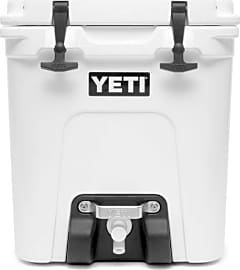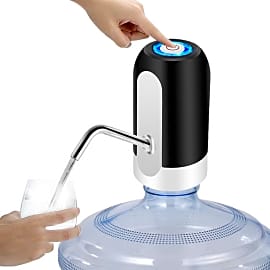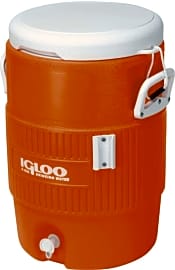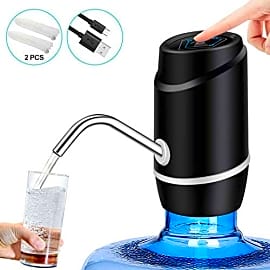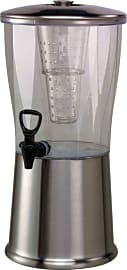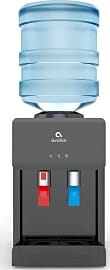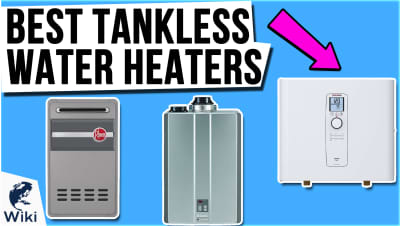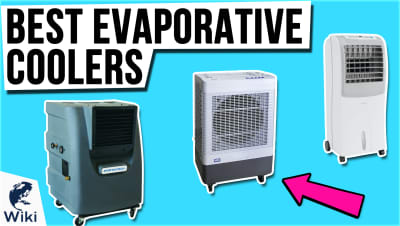The 10 Best Water Coolers

This wiki has been updated 40 times since it was first published in February of 2015. If you're feeling out of the loop in your office, it may be time to install a new water cooler to draw in the crowd. We’ve included several types, from mid-sized, top-loading models that sit on countertops to large, bottom-loading dispensers that look sleek and professional. Some even come in the form of a compact pumping device that screws onto the top of a five-gallon water jug. When users buy our independently chosen editorial choices, we may earn commissions to help fund the Wiki.
Editor's Notes
March 31, 2021:
We didn’t find any pressing need to make major updates to this list. Believing that the last editor for this page curated a nice mix of options — from basic pumps like the Datadago Universal and LeCiel Auto, to large warming and cooling fixtures like the HomeLabs Steel and Primo Top-Load – we felt that our users would still be well served by these rankings, and so decided to move on without making any significant changes.
If what you’re most interested isn’t so much the cooling ability of these water coolers, but rather the warming feature offered with top-end models, then you might be interested in our list of tankless water heaters. Installation will be a bit more involved (and may require professional assistance), and they can certainly be more costly, but many homeowners love the utility these devices offer.
February 26, 2020:
We removed all but one of the items on this list for an assortment of reasons: poor quality or durability, safety hazards, leaking issues, or a lack of availability. We retained the Primo Top-Load — an exceptional value for a freestanding model — noting its dependable performance and aesthetically pleasing appearance.
We intentionally included several styles in building out the rest of the rankings. In addition to standard freestanding coolers (both bottom and top-loading models), we added some compact options that can be placed on a kitchen counter and a couple small pumps that can be screwed to the top of a five-gallon water jug.
It’s worth pointing out that the Yeti Silo and Igloo EA are insulated to retain ice for an extended period of time. We’d also like to note that the Leciel Auto and Datadago Universal (the mini pump models) don’t cool the water; they simply dispense it. You can place ice in the Service Ideas CBDRT3SS, but there’s no guarantee it will last very long.
Special Honors
Quench Series Not only will these coolers dish out water at a moment’s notice, they’ll filter out chemicals, odors and other unwanted particles as well. They come in both freestanding and countertop designs, with easy-to-use digital display screens and tanks of various sizes. quenchwater.com
Filtrine Indestruct This line of coolers from Filtrine resembles the traditional, freestanding water fountain we’ve seen everywhere from schools to workplaces over the years. The main difference: their industrial-strength design, which allows them to withstand saltwater environments for use on ships. filtrine.com
Flaunt What You've Got
There's no chlorine taste, no calcium deposits, and no waiting around for water to heat up if you want to make some tea.
This ought to make you about as thirsty as it will make you sad: according to the UN, about 85% of the world's population lives in the driest half of the planet, and about 783 million people in the world don't have access to clean water. That is more than two United States combined.
Water is as vital a resource as there is, and the simple act of drinking more water can reduce incidences of diabetes, obesity, and other medical ailments. This is especially important in children and at the work place.
That's why these water coolers are such smart investments. They take the apparent convenience and refreshment of a cold soda and give it to you in a clean, crisp cup of water. There's no chlorine taste, no calcium deposits, and no waiting around for water to heat up if you want to make some tea. This makes for happier, more productive children and employees. Hopefully not child employees.
All of these coolers work on the same basic principals, as well. You have water shipped to you, or you refill your five and six gallon jugs where available. When I was growing up my town had a natural well that was free for residents to access, and we filled up there once a week.
Some of these coolers have you place the large jug upside down on top of the unit, allowing gravity to pull the water into two separate wells, one that cools the water and the other that heats it with a combination of electric power and temperature sharing. Essentially, the warmth that's drawn out of the room temperature water in the cooling process is incorporated into the maintenance of the hot water in its neighboring well.
Other models are bottom-loaded, which eliminates the dangerous and sometimes messy act of balancing a hefty water jug atop a three and a half foot cooler. These units have simple hoses that draw the water up from the jug and into the wells described above.
Simply pull the lever for hot or cold and voila! Fresh, clean water; the envy of the world.
Perfecting The Water Experience
The very simple, top-loading water cooler with a light blue and bright red tab for each of the two water temperatures is the standard image of these machines. Ask a child to draw a water cooler, and this is what you get. That may not be the case for long.
Bottom-loading coolers are getting more and more popular, as are more futuristic designs intended to fit in with modern appliances.
As noted, larger wells make for great office coolers, but take note of the service speed.
There are interesting competitive features for you to examine, like larger filling areas for coffee pots if you're putting the cooler in your office, filters to purify your water further, or automated cleaning functions. These are all well and good, but you have to ask yourself where you intend to put the cooler before you can grapple with the task of selection.
As noted, larger wells make for great office coolers, but take note of the service speed. After all, the water cooler is a common place for gossip to be shared and work to fall by the wayside. You should view any excuse for your employees to milk their time at the cooler as an unwelcome one.
In your home, you have to take the decor into account. If you're sporting the latest stainless steel everything in your kitchen, that bright white cooler with its frumpy blue jug is going to stick out like a sore thumb with a gambling problem in Vegas. You definitely want to look into a more aesthetically pleasing cooler, ideally one that can clean itself as much as possible, to reduce your work load in the home and to look good while doing it.
Gather Around The Watering Hole
The watering hole is a magical place. Animals of such disparate species gather there with greatly reduced levels of animosity toward one another, as though they have a deeper understanding as to the benefits and the necessity of the drink. Drop one human into the mix, though, and they scatter. We're repulsive like that, so we needed to create our own system.
We're repulsive like that, so we needed to create our own system.
While a glass jug with a block of ice in it has been used as a method for attaining cool water since humans began putting ice and water together, it wasn't until 1906 that a codified water cooler was created.
The inventors, Hasley Willard Taylor and Luther Haws, developed the unit to provide water that was sufficiently isolated to reduce the risk of spreading Typhoid fever, the very disease that claimed young Haws' father. Later, health concerns and basic demand for refreshment led the inventors to create a cooling system for their fountain that could kill additional microorganisms.
At a certain point in the history of the American workplace, the water cooler became a symbol for a brief pause in the day in which two workers could catch up with one another, refresh their minds as well as their bodies, and–in more recent days–trade perspectives on the latest medieval television drama.



